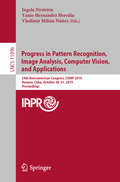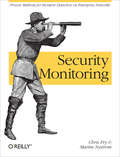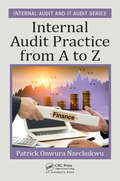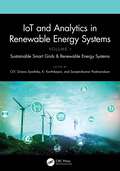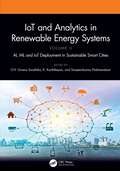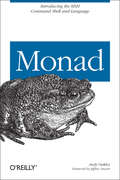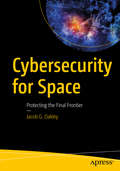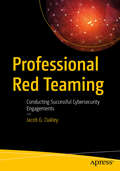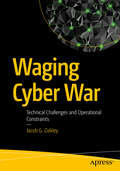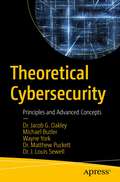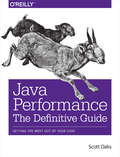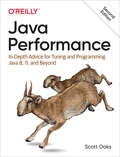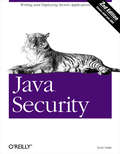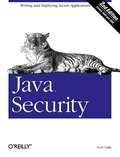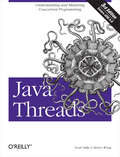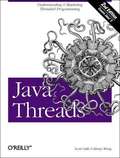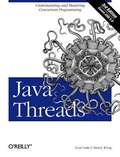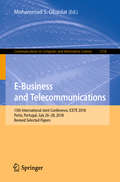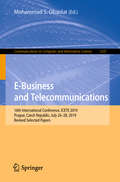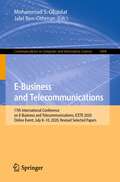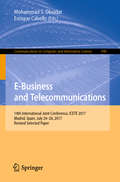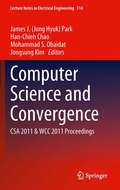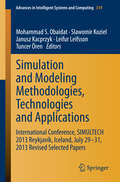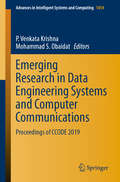- Table View
- List View
Progress in Pattern Recognition, Image Analysis, Computer Vision, and Applications: 24th Iberoamerican Congress, CIARP 2019, Havana, Cuba, October 28-31, 2019, Proceedings (Lecture Notes in Computer Science #11896)
by Ingela Nyström Yanio Hernández Heredia Vladimir Milián NúñezThis book constitutes the refereed conference proceedings of the 24rd Iberoamerican Congress on Pattern Recognition, CIARP 2019, held in Havana, Cuba, in October 2019. The 70 papers presented were carefully reviewed and selected from 128 submissions. The papers are organized in topical sections named: Data Mining: Natural Language Processing and Text Mining; Image Analysis and Retrieval; Machine Learning and Neural Networks; Mathematical Theory of Pattern Recognition; Pattern Recognition and Applications; Signals Analysis and Processing; Speech Recognition; Video Analysis.
Security Monitoring
by Martin Nystrom Chris FryHow well does your enterprise stand up against today's sophisticated security threats? In this book, security experts from Cisco Systems demonstrate how to detect damaging security incidents on your global network--first by teaching you which assets you need to monitor closely, and then by helping you develop targeted strategies and pragmatic techniques to protect them.Security Monitoring is based on the authors' years of experience conducting incident response to keep Cisco's global network secure. It offers six steps to improve network monitoring. These steps will help you: Develop Policies: define rules, regulations, and monitoring criteria Know Your Network: build knowledge of your infrastructure with network telemetry Select Your Targets: define the subset of infrastructure to be monitored Choose Event Sources: identify event types needed to discover policy violations Feed and Tune: collect data, generate alerts, and tune systems using contextual information Maintain Dependable Event Sources: prevent critical gaps in collecting and monitoring events Security Monitoring illustrates these steps with detailed examples that will help you learn to select and deploy the best techniques for monitoring your own enterprise network.
Internal Audit Practice from A to Z (Security, Audit and Leadership Series)
by Patrick Onwura NzechukwuInternal Audit Practice from A to Z addresses the practice of internal auditing using GAAS (Generally Accepted Auditing Standards), GAGAS (Generally Accepted Government Auditing Standards) and International Standards for the Professional Practice of Internal Auditing (Standards)-IPPF, International Standards Organization (ISO), International Standards of Supreme Audit Institutions (ISSAI), International Standards on Auditing (ISA) as enunciated by the Institute of Internal Auditors (IIA), International Organization of Standardizations (ISO), International Organization of Supreme Audit Institutions (INTOSAI), Government Accountability Office (GAO) & International Federation of Accountants (IFAC). Unique in that it is primarily written to guide internal auditors in the process and procedures necessary to carry out professionally accepted internal audit functions, the book includes everything necessary to start, complete, and evaluate an internal audit practice, simplifying the task for even non-professionals. Internal Audit Practice from A to Z features A rich array of forms, figures, tables, and reports, making it a practical, hands-on book Provides comprehensive content that contains all the practical guidance necessary to start, complete, and evaluate an internal audit practice Details on how to ensure quality on internal audit function through peer review Current international standards for the professional practice of internal auditing and other relevant standards for reference Checklists for all practice procedures as well as a checklist of the internal control of virtually all aspects of business function A blend of professional practice with theory. Internal Audit Practice from A to Z is comprehensively rich, global reference is a must for public, private, NGOs, institutions—every organization.
IoT and Analytics in Renewable Energy Systems (Volume 1): Sustainable Smart Grids & Renewable Energy Systems
by O. V. Gnana SwathikaSmart grid technologies include sensing and measurement technologies, advanced components aided with communications and control methods along with improved interfaces and decision support systems. Smart grid techniques support the extensive inclusion of clean renewable generation in power systems. Smart grid use also promotes energy saving in power systems. Cyber security objectives for the smart grid are availability, integrity and confidentiality. Five salient features of this book are as follows: AI and IoT in improving resilience of smart energy infrastructure IoT, smart grids and renewable energy: an economic approach AI and ML towards sustainable solar energy Electrical vehicles and smart grid Intelligent condition monitoring for solar and wind energy systems
IoT and Analytics in Renewable Energy Systems (Volume 2): AI, ML and IoT Deployment in Sustainable Smart Cities
by O. V. Gnana Swathika K. Karthikeyan Sanjeevikumar PadmanabanSmart cities emanate from a smart renewable-energy-aided power grid. The smart grid technologies offer an array of benefits like reliability, availability, and resiliency. Smart grids phenomenally contribute to facilitating cities reaching those sustainability goals over time. Digital technologies, such as the Internet of Things (IoT), automation, artificial intelligence (AI) and machine learning (ML) significantly contribute to the two-way communication between utilities and customers in smart cities. Five salient features of this book are as follows: Smart grid to the smart customer Intelligent computing for smart grid applications Novel designs of IoT systems such as smart healthcare, smart transportation, smart home, smart agriculture, smart manufacturing, smart grid, smart education, smart government, smart traffic management systems Innovations in using IoT and AI in improving resilience of smart energy infrastructure Challenges and future research directions of smart city applications
Monad (AKA PowerShell)
by Andy OakleyWindows PowerShell, formerly know by its codename "Monad" and available now for Windows Server 2003, Windows XP, and Windows Vista, and soon for Exchange Server 2007 and MOM, is the future of Windows administration. From setting up automated build environments to managing 20,000 Exchange email clients in an organization, any tool that reduces the number of repetitive steps an administrator must perform, is a real win. Even better, PowerShell part of a major Microsoft initiative that aims to replace a host of Windows management tools with a single, unified shell. This is the promise of PowerShell and the reason IT professionals need to start learning how to use it today Reflecting the best of legacy tools such as bash and the Korn shell, PowerShell also breaks new ground in its command language design and its use of the object-oriented .NET Framework. And there is no better way to learn how to put PowerShell to work than to get your hands on Monad, O'Reilly's innovative, hands-on introduction to the tool. This concise 200-page book is an exciting tour of some of the new capabilities that PowerShell puts into the hands of system administrators and power users, and is the perfect complement to existing PowerShell documentation. With more than 40 hands-on activities, the book covers every angle, from using PowerShell commands and its object-oriented pipelines to querying systems, generating reports and writing scripts that automate existing tasks. Adding to the lure is the fact that the book is written by Microsoft manager, Andy Oakley with a Foreword by PowerShell architect Jeffrey Snover-so you can be certain that it's teeming with inside information. Monad lets you see for yourself how PowerShell can significantly improve your productivity. Because the PowerShell technology has wide appeal, so, too, does this compact guide. Developers, administrators, and power users alike can all benefit from its insight. If you're someone who habitually drifts toward the c-m-d keys, knows all of the switches to most command tools, or spends time authoring batch files to solve new challenges, this book is right up your alley. And if your organization plans to upgrade soon to Exchange 2007 or MOM V3, there's no time to waste. Breaking News: A PowerShell RC1 Update to the book is now available at no charge from the book's catalog page on oreilly.com!
Cybersecurity for Space: Protecting the Final Frontier
by Jacob G. OakleyThis is the first book of its kind to cover the unique challenges of creating, maintaining, and operating a system that operates in both outer space and cyber space. It covers the impact that cyber threats can have on space systems and how the cybersecurity industry must rise to meet the threats. Space is one of the fastest growing military, government, and industry sectors. Because everything in today’s world exists within or connected to cyberspace, there is a dire need to ensure that cybersecurity is addressed in the burgeoning field of space operations. You will be introduced to the basic concepts involved in operating space systems that include low earth orbit (LEO), geosynchronous orbit (GEO), and others. Using the related high-level constraints, threats, and vectors, you will be able to frame a clear picture of the need and challenges of bringing cybersecurity to bear on satellites, space vehicles, and their related systems. The author, who has spent seven years in the US Marine Corps and was originally involved in satellite communications and later cyber operations, is now a seasoned cybersecurity practitioner currently implementing cybersecurity vision and strategy to a large portfolio of systems and programs, many focused specifically in space. A published academic and experienced professional, he brings a practical, real-world and tempered approach to securing space vehicles and their systems. What You Will Learn Understand what constitutes a space system and the challenges unique to operations of all spacecraftGet introduced to various space vehicles and their unique constraints and challengesBe aware of the physical and cyber threats to the space vehicle and its ability to fly and orbitKnow the physical and cyber vectors from which threats may manifestStudy the micro- and macro-analysis provided of space system attack scenariosBe familiar with the high-level problems of cybersecurity in the space domain Who This Book Is For This book is written for two audiences: those with a background in space operations as well as those in cybersecurity. It offers the guidance needed to understand the unique challenges to space operations that affect the implementation of cybersecurity.
Professional Red Teaming: Conducting Successful Cybersecurity Engagements
by Jacob G. OakleyUse this unique book to leverage technology when conducting offensive security engagements. You will understand practical tradecraft, operational guidelines, and offensive security best practices as carrying out professional cybersecurity engagements is more than exploiting computers, executing scripts, or utilizing tools.Professional Red Teaming introduces you to foundational offensive security concepts. The importance of assessments and ethical hacking is highlighted, and automated assessment technologies are addressed. The state of modern offensive security is discussed in terms of the unique challenges present in professional red teaming.Best practices and operational tradecraft are covered so you feel comfortable in the shaping and carrying out of red team engagements. Anecdotes from actual operations and example scenarios illustrate key concepts and cement a practical understanding of the red team process.You also are introduced to counter advanced persistent threat red teaming (CAPTR teaming). This is a reverse red teaming methodology aimed at specifically addressing the challenges faced from advanced persistent threats (APTs) by the organizations they target and the offensive security professionals trying to mitigate them. What You’ll Learn Understand the challenges faced by offensive security assessmentsIncorporate or conduct red teaming to better mitigate cyber threatsInitiate a successful engagementGet introduced to counter-APT red teaming (CAPTR)Evaluate offensive security processes Who This Book Is For Offensive security assessors and those who want a working knowledge of the process, its challenges, and its benefits. Current professionals will gain tradecraft and operational insight and non-technical readers will gain a high-level perspective of what it means to provide and be a customer of red team assessments.
Waging Cyber War: Technical Challenges and Operational Constraints
by Jacob G. OakleyUnderstand the challenges of implementing a cyber warfare strategy and conducting cyber warfare. This book addresses the knowledge gaps and misconceptions of what it takes to wage cyber warfare from the technical standpoint of those with their hands on the keyboard. You will quickly appreciate the difficulty and complexity of executing warfare within the cyber domain. Included is a detailed illustration of cyber warfare against the backdrop of national and international policy, laws, and conventions relating to war.Waging Cyber War details technical resources and activities required by the cyber war fighter. Even non-technical readers will gain an understanding of how the obstacles encountered are not easily mitigated and the irreplaceable nature of many cyber resources. You will walk away more informed on how war is conducted from a cyber perspective, and perhaps why it shouldn’t be waged. And you will come to know how cyber warfare has been covered unrealistically, technically misrepresented, and misunderstood by many. What You’ll Learn Understand the concept of warfare and how cyber fits into the war-fighting domainBe aware of what constitutes and is involved in defining war and warfare as well as how cyber fits in that paradigm and vice versaDiscover how the policies being put in place to plan and conduct cyber warfare reflect a lack of understanding regarding the technical means and resources necessary to perform such actionsKnow what it means to do cyber exploitation, attack, and intelligence gathering; when one is preferred over the other; and their specific values and impacts on each otherBe familiar with the need for, and challenges of, enemy attributionRealize how to develop and scope a target in cyber warfareGrasp the concept of self-attribution: what it is, the need to avoid it, and its impactSee what goes into establishing the access from which you will conduct cyber warfare against an identified targetAppreciate how association affects cyber warfareRecognize the need for resource resilience, control, and ownershipWalk through the misconceptions and an illustrative analogy of why cyber warfare doesn't always work as it is prescribed Who This Book Is For Anyone curious about warfare in the era of cyber everything, those involved in cyber operations and cyber warfare, and security practitioners and policy or decision makers. The book is also for anyone with a cell phone, smart fridge, or other computing device as you are a part of the attack surface.
Theoretical Cybersecurity: Principles and Advanced Concepts
by Jacob G. Oakley Michael Butler Wayne York Matthew Puckett J. Louis SewellThere is a distinct lack of theoretical innovation in the cybersecurity industry. This is not to say that innovation is lacking, as new technologies, services, and solutions (as well as buzzwords) are emerging every day. This book will be the first cybersecurity text aimed at encouraging abstract and intellectual exploration of cybersecurity from the philosophical and speculative perspective. Technological innovation is certainly necessary, as it furthers the purveying of goods and services for cybersecurity producers in addition to securing the attack surface of cybersecurity consumers where able. The issue is that the industry, sector, and even academia are largely technologically focused. There is not enough work done to further the trade—the craft of cybersecurity. This book frames the cause of this and other issues, and what can be done about them. Potential methods and directions are outlined regarding how the industry can evolve to embrace theoretical cybersecurity innovation as it pertains to the art, as much as to the science. To do this, a taxonomy of the cybersecurity body of work is laid out to identify how the influences of the industry’s past and present constrain future innovation. Then, cost-benefit analysis and right-sizing of cybersecurity roles and responsibilities—as well as defensible experimentation concepts—are presented as the foundation for moving beyond some of those constraining factors that limit theoretical cybersecurity innovation. Lastly, examples and case studies demonstrate future-oriented topics for cybersecurity theorization such as game theory, infinite-minded methodologies, and strategic cybersecurity implementations. What you’ll learn The current state of the cybersecurity sector and how it constrains theoretical innovation How to understand attacker and defender cost benefit The detect, prevent, and accept paradigm How to build your own cybersecurity box Supporting cybersecurity innovation through defensible experimentation How to implement strategic cybersecurity Infinite vs finite game play in cybersecurity Who This Book Is For This book is for both practitioners of cybersecurity and those who are required to, or choose to, employ such services, technology, or capabilities.
Java Performance: The Definitive Guide
by Scott OaksCoding and testing are often considered separate areas of expertise. In this comprehensive guide, author and Java expert Scott Oaks takes the approach that anyone who works with Java should be equally adept at understanding how code behaves in the JVM, as well as the tunings likely to help its performance.You'll gain in-depth knowledge of Java application performance, using the Java Virtual Machine (JVM) and the Java platform, including the language and API. Developers and performance engineers alike will learn a variety of features, tools, and processes for improving the way Java 7 and 8 applications perform.Apply four principles for obtaining the best results from performance testingUse JDK tools to collect data on how a Java application is performingUnderstand the advantages and disadvantages of using a JIT compilerTune JVM garbage collectors to affect programs as little as possibleUse techniques to manage heap memory and JVM native memoryMaximize Java threading and synchronization performance featuresTackle performance issues in Java EE and Java SE APIsImprove Java-driven database application performance
Java Performance: In-Depth Advice for Tuning and Programming Java 8, 11, and Beyond
by Scott OaksCoding and testing are generally considered separate areas of expertise. In this practical book, Java expert Scott Oaks takes the approach that anyone who works with Java should be adept at understanding how code behaves in the Java Virtual Machine—including the tunings likely to help performance. This updated second edition helps you gain in-depth knowledge of Java application performance using both the JVM and the Java platform.Developers and performance engineers alike will learn a variety of features, tools, and processes for improving the way the Java 8 and 11 LTS releases perform. While the emphasis is on production-supported releases and features, this book also features previews of exciting new technologies such as ahead-of-time compilation and experimental garbage collections.Understand how various Java platforms and compilers affect performanceLearn how Java garbage collection worksApply four principles to obtain best results from performance testingUse the JDK and other tools to learn how a Java application is performingMinimize the garbage collector’s impact through tuning and programming practicesTackle performance issues in Java APIsImprove Java-driven database application performance
Java Security
by Scott OaksJava's most striking claim is that it provides a secure programming environment. However, despite lots of discussion, few people understand precisely what Java's claims mean and how it backs up those claims. Java Security is an in-depth exploration aimed at developers, network administrators, and anyone who needs to work with or understand Java's security mechanisms. It discusses in detail what security does and doesn't mean, what Java's default security policies are, and how to create and implement your own policies. In doing so, Java Security provides detailed coverage of security managers, class loaders, the access controller, and much of the java.security package. It discusses message digests, certificates, and digital signatures, showing you how to use Java's facilities for signing classes or to implement your own signature facility. It shows you how to write a class loader that recognizes signed classes, verifies the signature, and cooperates with a security manager to grant additional privileges. It also discusses the problem of managing cryptographic keys and shows you how to implement your own key management systems. Java Security is an essential book for everyone using Java in real-world software. If you're deploying software written in Java, you need to know how to grant your classes the privileges they need, without granting privileges to untrusted classes. You need to know how to protect your systems against intrusion and corruption. Java provides the tools; this book shows you how to use them.
Java Security, 2nd Edition
by Scott OaksThe second edition focuses on the platform features of Java that provide security--the class loader, bytecode verifier, and security manager--and recent additions to Java that enhance this security model: digital signatures, security providers, and the access controller. The book covers in depth the security model of Java 2, version 1.3, including the two new security APIs: JAAS and JSSE.
Java Security, 2nd Edition
by Scott OaksOne of Java's most striking claims is that it provides a secure programming environment. Yet despite endless discussion, few people understand precisely what Java's claims mean and how it backs up those claims. If you're a developer, network administrator or anyone else who must understand or work with Java's security mechanisms, Java Security is the in-depth exploration you need. Java Security, 2nd Edition, focuses on the basic platform features of Java that provide security--the class loader, the bytecode verifier, and the security manager--and recent additions to Java that enhance this security model: digital signatures, security providers, and the access controller. The book covers the security model of Java 2, Version 1.3, which is significantly different from that of Java 1.1. It has extensive coverage of the two new important security APIs: JAAS (Java Authentication and Authorization Service) and JSSE (Java Secure Sockets Extension). Java Security, 2nd Edition, will give you a clear understanding of the architecture of Java's security model and how to use that model in both programming and administration. The book is intended primarily for programmers who want to write secure Java applications. However, it is also an excellent resource for system and network administrators who are interested in Java security, particularly those who are interested in assessing the risk of using Java and need to understand how the security model works in order to assess whether or not Java meets their security needs.
Java Threads, 2nd Edition
by Scott Oaks Henry WongRevised and expanded to cover Java 2, Java Threads shows you how to take full advantage of Java's thread facilities: where to use threads to increase efficiency, how to use them effectively, and how to avoid common mistakes. It thoroughly covers the Thread and ThreadGroup classes, the Runnable interface, and the language's synchronized operator. The book pays special attention to threading issues with Swing, as well as problems like deadlock, race condition, and starvation to help you write code without hid
Java Threads, 2nd Edition
by Scott Oaks Henry WongThreads aren't a new idea: many operating systems and languages support them. But despite widespread support, threads tend to be something that everyone talks about, but few use. Programming with threads has a reputation for being tricky and nonportable. Not so with Java. Java's thread facilities are easy to use, and--like everything else in Java--are completely portable between platforms. And that's a good thing, because it's impossible to write anything but the simplest applet without encountering threads. If you want to work with Java, you have to learn about threads. This new edition shows you how to take full advantage of Java's thread facilities: where to use threads to increase efficiency, how to use them effectively, and how to avoid common mistakes. Java Threads discusses problems like deadlock, race condition, and starvation in detail, helping you to write code without hidden bugs. It brings you up to date with the latest changes in the thread interface for JDK 1.2. The book offers a thorough discussion of the Thread and ThreadGroup classes, the Runnable interface, the language's synchronized operator. It explains thread scheduling ends by developing a CPUSchedule class, showing you how to implement your own scheduling policy. In addition, Java Threads shows you how to extend Java's thread primitives. Other extended examples include classes that implement reader/writer locks, general locks, locks at arbitrary scope, and asynchronous I/O. This edition also adds extensive examples on thread pools, advanced synchronization technique, like condition variables, barriers, and daemon locks. It shows how to work with classes that are not thread safe, and pays special attention to threading issues with Swing. A new chapter shows you how to write parallel code for multiprocessor machines. In short, Java Threads covers everything you need to know about threads, from the simplest animation applet to the most complex applications. If you plan to do any serious work in Java, you will find this book invaluable. Examples available online. Covers Java 2.
Java Threads, Third Edition
by Scott Oaks Henry WongThreads are essential to Java programming, but learning to use them effectively is a nontrivial task. This new edition of the classic Java Threads shows you how to take full advantage of Java's threading facilities and brings you up-to-date with the watershed changes in Java 2 Standard Edition version 5.0 (J2SE 5.0). It provides a thorough, step-by-step approach to threads programming.
E-Business and Telecommunications: 15th International Joint Conference, ICETE 2018, Porto, Portugal, July 26–28, 2018, Revised Selected Papers (Communications in Computer and Information Science #1118)
by Mohammad S. ObaidatThis book constitutes the refereed proceedings of the 15th International Joint Conference on E-Business and Telecommunications, ICETE 2018, held in Porto, Portugal, in July 2018.ICETE is a joint international conference integrating four major areas of knowledge that are divided into six corresponding conferences: International Conference on Data Communication Networking, DCNET; International Conference on E-Business, ICE-B; International Conference on Optical Communication Systems, OPTICS; International Conference on Security and Cryptography, SECRYPT; International Conference on Signal Processing and Multimedia, SIGMAP; International Conference on Wireless Information Systems, WINSYS. The 11 full papers presented in the volume were carefully reviewed and selected from the 201 submissions. The papers cover the following key areas of information and communication technologies: data communication networking, e-business, optical communication systems, security and cryptography, signal processing and multimedia applications, and wireless networks and mobile systems.
E-Business and Telecommunications: 16th International Conference, ICETE 2019, Prague, Czech Republic, July 26–28, 2019, Revised Selected Papers (Communications in Computer and Information Science #1247)
by Mohammad S. ObaidatThis book constitutes the refereed proceedings of the 16th International Joint Conference on E-Business and Telecommunications, ICETE 2019, held in Prague, Czech Republic, in July 2019.ICETE is a joint international conference integrating four major areas of knowledge that are divided into six corresponding conferences: International Conference on Data Communication Networking, DCNET; International Conference on E-Business, ICE-B; International Conference on Optical Communication Systems, OPTICS; International Conference on Security and Cryptography, SECRYPT; International Conference on Signal Processing and Multimedia, SIGMAP; International Conference on Wireless Information Systems, WINSYS. The 11 full papers presented in the volume were carefully reviewed and selected from the 166 submissions. The papers cover the following key areas of data communication networking, e-business, security and cryptography, signal processing and multimedia applications.
E-Business and Telecommunications: 17th International Conference on E-Business and Telecommunications, ICETE 2020, Online Event, July 8–10, 2020, Revised Selected Papers (Communications in Computer and Information Science #1484)
by Mohammad S. Obaidat Jalel Ben-OthmanThe present book includes extended and revised versions of a set of selected papers presented at the 17th International Joint Conference on e-Business and Telecommunications, ICETE 2020, held as an online web-based event (due to the COVID-19 pandemic) in July 2020.ICETE 2020 is a joint conference aimed at bringing together researchers, engineers and practitioners interested in information and communication technologies, including data communication networking, e-business, optical communication systems, security and cryptography, signal processing and multimedia applications, and wireless networks and mobile systems.The 10 full papers included in the volume were carefully selected from the 30 submissions accepted to participate in the conference.
E-Business and Telecommunications: 14th International Joint Conference, ICETE 2017, Madrid, Spain, July 24-26, 2017, Revised Selected Paper (Communications in Computer and Information Science #990)
by Mohammad S. Obaidat Enrique CabelloThis book constitutes the refereed proceedings of the 14th International Joint Conference on E-Business and Telecommunications, ICETE 2017, held in Madrid, Spain, in July 2017. ICETE is a joint international conference integrating four major areas of knowledge that are divided into six corresponding conferences: International Conference on Data Communication Networking, DCNET; International Conference on E-Business, ICE-B; International Conference on Optical Communication Systems, OPTICS; International Conference on Security and Cryptography, SECRYPT; International Conference on Signal Processing and Multimedia, SIGMAP; International Conference on Wireless Information Systems, WINSYS. The 17 full papers presented were carefully reviewed and selected from 195 submissions. The papers cover the following key areas of information and communication technologies, including data communication and networking, e-business and telecommunications: data communication networking; e-business; optical communication systems; security and cryptography; signal processing and multimedia applications; wireless networks and mobile systems.
Computer Science and Convergence: CSA 2011 & WCC 2011 Proceedings (Lecture Notes in Electrical Engineering #114)
by Mohammad S. Obaidat Jongsung Kim Han-Chieh Chao James Jong ParkComputer Science and Convergence is proceedings of the 3rd FTRA International Conference on Computer Science and its Applications (CSA-11) and The 2011 FTRA World Convergence Conference (FTRA WCC 2011). The topics of CSA and WCC cover the current hot topics satisfying the world-wide ever-changing needs. CSA-11 will be the most comprehensive conference focused on the various aspects of advances in computer science and its applications and will provide an opportunity for academic and industry professionals to discuss the latest issues and progress in the area of CSA. In addition, the conference will publish high quality papers which are closely related to the various theories and practical applications in CSA. Furthermore, we expect that the conference and its publications will be a trigger for further related research and technology improvements in this important subject. The main scope of CSA-11 is as follows: - Mobile and ubiquitous computing - Dependable, reliable and autonomic computing - Security and trust management - Multimedia systems and services - Networking and communications - Database and data mining - Game and software engineering - Grid, cloud and scalable computing - Embedded system and software - Artificial intelligence - Distributed and parallel algorithms - Web and internet computing - IT policy and business management WCC-11 is a major conference for scientists, engineers, and practitioners throughout the world to present the latest research, results, ideas, developments and applications in all areas of convergence technologies. The main scope of WCC-11 is as follows: - Cryptography and Security for Converged environments - Wireless sensor network for Converged environments - Multimedia for Converged environments - Advanced Vehicular Communications Technology for Converged environments - Human centric computing, P2P, Grid and Cloud computing for Converged environments - U-Healthcare for Converged environments - Strategic Security Management for Industrial Technology - Advances in Artificial Intelligence and Surveillance Systems
Simulation and Modeling Methodologies, Technologies and Applications
by Mohammad S. Obaidat Slawomir Koziel Janusz Kacprzyk Leifur Leifsson Tuncer ÖrenThis book includes extended and revised versions of a set of selected papers from the 3rd International Conference on Simulation and Modeling Methodologies, Technologies and Applications (SIMULTECH 2013) which was co-organized by the Reykjavik University (RU) and sponsored by the Institute for Systems and Technologies of Information, Control and Communication (INSTICC). SIMULTECH 2013 was held in cooperation with the ACM SIGSIM - Special Interest Group (SIG) on SImulation and Modeling (SIM), Movimento Italiano Modellazione e Simulazione (MIMOS) and AIS Special Interest Group on Modeling and Simulation (AIS SIGMAS) and technically co-sponsored by the Society for Modeling & Simulation International (SCS), Liophant Simulation, Simulation Team and International Federation for Information Processing (IFIP). This proceedings brings together researchers, engineers, applied mathematicians and practitioners working in the advances and applications in the field of system simulation.
Emerging Research in Data Engineering Systems and Computer Communications: Proceedings of CCODE 2019 (Advances in Intelligent Systems and Computing #1054)
by Mohammad S. Obaidat P. Venkata KrishnaThis book gathers selected papers presented at the 2nd International Conference on Computing, Communications and Data Engineering, held at Sri Padmavati Mahila Visvavidyalayam, Tirupati, India from 1 to 2 Feb 2019. Chiefly discussing major issues and challenges in data engineering systems and computer communications, the topics covered include wireless systems and IoT, machine learning, optimization, control, statistics, and social computing.
